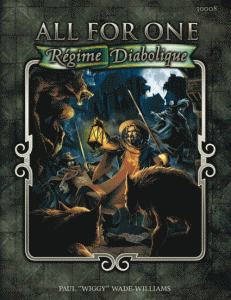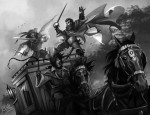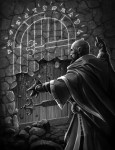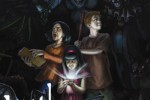All for One: Régime Diabolique
All for One: Régime Diabolique is a complete role-playing game powered by the Ubiquity system and published by Triple Ace Games.
By Paul ‘Wiggy’ Wade-Williams

Welcome to the third Designer’s Diary, a regular column where designers are given the opportunity to take readers on an in-depth ride through the design and development process of their system, setting, or product.
Designer’s Description
In two words, swashbuckling horror. There’s a lot of leeway in that genre mix, though. With a simple tweak of the game mechanics you can run something really dark and gritty with few supernatural elements, or camp it up to the level of Buffy the Vampire Slayer™.
The core rules make the assumption you’re a King’s Musketeer. A range of inexpensive PDFs (the Richelieu’s Guide to series) provide options for other occupations, but sticking everyone together in one organization provides instant party unity and gives the characters a focus. That might sound a little restrictive at first, but there are wide ranging options. There is something like a dozen sample characters in the rulebook, and while they are all Musketeers, each has a unique slant. So we have an alchemist, a duelist, a former artillery gunner, an aspiring officer, and a messenger, for example.
All for One is very much set in our world, but it’s one where the horrors people feared existed do actually exist. Magic is a real and potent phenomenon, but it’s very much tied into manipulating spirits—mages don’t have mystical powers per se, but rather mystical knowledge. A mage casting a “fireball” spell, for example, doesn’t draw on his own inner energy or some nameless mystical force; he summons a fire elemental to do his bidding.
Purpose
I write games I want to play, and All for One was no different. I think the idea came on trip to visit my in-laws. I’d just purchased an encyclopedia of angels and was flicking through it on the drive up (I wasn’t driving). Purely by fate I happened to glance at an entry for a demon prince assigned to torment France. That immediately got the wheels turning, and within a few minutes the core idea of Musketeers vs. demons was forming.

Influences
The Three Musketeers movies from the 1970s were the main influence. I wanted to create something that had the same level of fun, action, and intrigue, but with demons and witches as the opposition.
Research
To be honest, there was very little research involved in the core rules. Some fans have commented on the lack of historical details, but at the end of the day I am assigned a finite page count to fill, and I decided to write a setting that was fun to play. The internet and libraries are full of books on France in the 17th century, so anyone needing information beyond the basic level we provided has plenty of free material to draw upon.

Art Direction
The art is fantastic. We used one of our regular artists for every piece of art, ensuring uniformity in style and detail from cover to cover. We don’t like to limit the artist to our vision, so we tend to keep briefs very vague. For instance, we might just say “Musketeers fighting a werewolf.” Beyond that, the artist is free to draw what he wants.
None of the images are static. That is, they aren’t just images of Musketeers doing nothing but standing around. Every image screams out for the viewer to ask question about the scene. For instance, there’s one scene depicting a Musketeer fighting two assailants. He’s using a cloak to entangle one while he simultaneously parries a sword coming in from “off camera.” Just looking at the art made me wonder why the Musketeer was being attacked, and who was out of shot thrusting at him with a blade.
 The actual imagery ties perfectly into the flavor of the setting. Some focus on the non-supernatural elements in the game. There are images of a Musketeer bowing to a beautiful lady, a reminder that romance is a strong part of the genre, and heroes getting into a barroom brawl, another staple of the genre, especially in the movies. Those involving the supernatural depict many of the more common monsters, as well as a sinister cowled warlock summoning a demon, a member of the clergy using his cross to banish demonic spirits from a witch being burned at the stake, and so on.
The actual imagery ties perfectly into the flavor of the setting. Some focus on the non-supernatural elements in the game. There are images of a Musketeer bowing to a beautiful lady, a reminder that romance is a strong part of the genre, and heroes getting into a barroom brawl, another staple of the genre, especially in the movies. Those involving the supernatural depict many of the more common monsters, as well as a sinister cowled warlock summoning a demon, a member of the clergy using his cross to banish demonic spirits from a witch being burned at the stake, and so on.
Gaming Experience
Above all, a fun one! The setting was written to allow cool stunts and tricks as standard actions rather than something you need special abilities to perform, and the Style point reward system actively encourages such behavior. All for One uses the Ubiquity™ rules, a simple, elegant system intended to maximize storytelling and reduce die rolling. It’s very easy to learn and great fun to play.
Comparison
My only real experience of swashbuckling products comes from the brilliant Flashing Blades and 7th Sea RPGs, but these are very different products to All for One. Flashing Blades is very much a “normal” world, one full of dashing heroes and sinister villains for sure, but with no real supernatural elements. 7th Sea has both mundane and supernatural elements, but it felt more like a fantasy game at times because of the various forms of magic. Its horror elements were more limited than in All for One, where they are at the very center of the game.
Development Process
People are usually disappointed when I answer this question, so you’ve been warned. Once I have the basic idea for a setting I sit down, start typing, and see what comes out. I usually have vague chapter headings in mind, but I never meticulously plan the contents beforehand. Usually I start on the mundane side of design—getting character generation and equipment out of the way.
While I’m writing one section my imagination has the time to start working out the really cool parts and how they fit together. For instance, I was thinking of how to work Milady de Winter into the game when the Daughters of Medea, an organization of female assassins and manipulators of men, popped into my head.
I’m a great fan of not giving GMs all the answers in black and white. I like to leave hints and clues about what might be, rather than telling the reader what is. For instance, the section on the Daughters of Medea suggests the Queen of France is rumored to be their leader, but that is never confirmed or denied. That approach can lead to fans asking for clarification, but my answer is always the same—once you buy the book it is your world to play with in any way you want. Hints provide the GM with possibilities, but they also leave him tremendous scope for using his own imagination.




